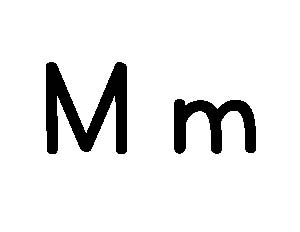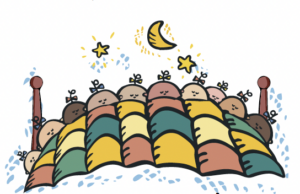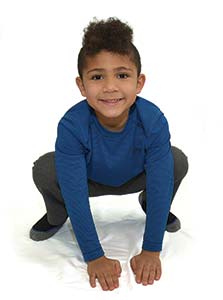Phonological awareness
Children will strengthen their understanding of initial sounds in words.


Review:
What sound do you hear at the beginning of the word “song”? (/s/)
 Let’s sing together the “Bingo” song!
Let’s sing together the “Bingo” song!
[Lead children in singing the first verse of “Bingo.”]
What letter sound do we hear at the beginning of the word “Bingo”?
 The word “Bingo” begins with the /b/-/b/-/b/ sound. We are going to pretend Bingo changed his name. We will change the first letter in the word “Bingo.”
The word “Bingo” begins with the /b/-/b/-/b/ sound. We are going to pretend Bingo changed his name. We will change the first letter in the word “Bingo.”
[Place the letter M on top of the letter B on the whiteboard.]
M says /m-m-m/. Now his name would be Mingo! Let’s say his new name together: Mingo. Now let’s sing the song using his new name, Mingo!
[Together sing the first verse of the song with “Mingo.”]
Let’s change Bingo’s name again!
[Replace the first letter in the word “Bingo” again with the letter F. Ask children to figure out what Bingo’s name will be with the letter F replacing the letter B. Sing the first verse of the song with the letter F. If time permits, sing the song a final time using the letter P to replace the letter B in the word “Bingo.”]
Now we are going to play our funny name game again. I am going to say one of your names without its beginning sound.
We know a name can sound different without its beginning sound. If I took off the /n/ sound from the beginning of the name “Nancy,” we would have the word “ancy.” “Ancy” is what is left of the name “Nancy” when we take off the /n/ sound. Let’s try it with our own names! Remember to raise your hand if you think I am saying your name without its beginning sound.
[Say each child’s name, one at a time, without its beginning sound. Encourage each child to raise his/her hand if he/she believes you are saying his/her name. Encourage the child to say his/her name without the initial sound (repeat what you say). Remind children not to say whose name they think it is out loud so that each child will have a turn determining if you are saying his/her name. Continue until you’ve said each child’s name.]
Today we sang the song “Bingo” while thinking about the beginning sound in the word “Bingo.” We also played our funny name game where we listen for our name without its beginning sound. Did your name sound the same without its beginning sound?
Extra support
Enrichment
Provide a small whiteboard with the word “Bingo” written on it and letters H and R written on squares of paper. Invite children to continue the song learned during the activity as they cover the letter B with different letters.
Invite school-age children to think of animal names and take the initial sound away from the animal name. Encourage younger children to guess the animal. Example: “This animal squeaks. It is an ‘ouse.”’ (mouse) “This animal likes to hop. It is an ‘abbit’.” (rabbit) Encourage younger children to say the letter sound that is missing from the beginning of the word.
Number knowledge
Children will broaden their understanding of how to determine which numeral is one more than a given numeral.


Review:

Be Prepared: Place numeral cards in the basket. Children sit around a table for this activity.
Today we will practice finding one more.
[Place the basket of cards in a central location on the table. Put 10 items of similar size and color in front of you.]
There is a basket of number cards on our table. Each of us will have 10 items in front of us. We will take turns choosing a number card and then counting out the number of items that is one more than the number card we chose. Let me show you.
[Choose a numeral card from the basket. Say the numeral name, and then count out the corresponding number of items. Move each item into a small group as you count it. Then count one more. Emphasize the “one more” item as you count it. Then say the total number. Example: “I have five circles when I add one more.”]
Now it is your turn to try.

[Give each child a group of 10 or fewer counting items that are similar in size and color. Invite a volunteer child to begin. Provide verbal guidance if appropriate.
Continue until each child has had a turn. Repeat the activity if time permits.]
Today we used counting items again. Each of us chose a number card and counted out the number of items that was one more than the number on the number card we chose.
[If time permits, sing the adjacent song:]
Extra support
Enrichment
Supply the counting items and *small numeral cards used during today’s activity. Invite children to continue the activity.
*Printables provided
Invite school-age children to count out four more items.
Motor development
Children will balance and shift their weight by standing on one leg and by pretending to jump like a frog.


New:
Review:

Be Prepared: Children will stand on one leg and also extend their legs slightly into the air when shifting their weight to their hands in today’s activity. Be sure children are spaced sufficiently far apart so they will not bump into anyone. Ask another adult to help with the activity, especially when children try to stand on one leg.
We are learning how to balance our bodies when we move them. Balancing our bodies helps us not fall down. Today we will practice some different ways to balance our bodies.
Please stand up. Let’s pay attention to how our feet and legs help us keep our balance.
Each of us has weight. We know that weight is how heavy something is. Right now both of our feet and legs are holding the weight of our body.
We can shift our weight to one of our legs. Shift means to move something from one place to another place. We can shift our weight from one leg and foot to another leg and foot.
[Demonstrate—or invite a volunteer child or other adult to demonstrate—the actions described below. In the first action, alternate lifting a foot slightly off the floor as you move your body weight from one side to the other side. In the second and third actions, hold out your arm that is opposite the foot and leg you are standing on.]
I am moving my body from side to side. I am shifting the weight of my body from one foot to my other foot. When I stand on one foot, I am slightly lifting my opposite foot. My opposite foot is my other foot. Our foot that is on the floor is on one side of our body. My opposite foot is on the other side of my body. Right now we want to lift our foot that is on the opposite (other) side of our body.
Now it is your turn to try to move your body from side to side. Please shift your weight from one foot to your other foot.
[Provide verbal guidance as appropriate.]
Now I am going to stand on one foot and leg. Please watch me shift the weight of my body to one leg and foot.
How am I using another part of my body to help me keep my balance (not fall over)? (putting out arm)
My body might tip over if I do not put out my arm that is opposite of the foot and leg I am standing on.
Let’s all try to stand on one foot and leg. Remember to use your opposite arm to help you balance your body.
[Provide verbal guidance as appropriate.]
Please stand on both of your feet. What is holding the weight of your body right now? (both legs)
Now let’s stand on our other foot and leg. Remember to use your opposite arm to help you keep your balance.
[Provide verbal guidance as appropriate.]
Let’s shift our weight by standing on one foot and leg and then standing on our other foot and leg. Pay attention to how we keep our balance. We want to move slowly from one foot and leg to our other foot and leg. If we shift our weight too fast, we may lose our balance and fall over.
Another way we can practice shifting our weight is to pretend we are frogs. Here is a picture of what it looks like to put our body in a frog position.
 [Display picture of child in frog position. Invite volunteer child to demonstrate frog position by bending legs while moving them apart and putting hands in front of body. See picture. Describe for all children what volunteer child is doing.]
[Display picture of child in frog position. Invite volunteer child to demonstrate frog position by bending legs while moving them apart and putting hands in front of body. See picture. Describe for all children what volunteer child is doing.]
Now (volunteer child) can show us how to jump like a frog.
[Ask volunteer child to remain on the floor with bended legs and:
(Volunteer child) shifted the weight of his/her body to his/her hands when he/she leaned forward and then jumped by moving his/her feet/legs.
Let’s all try to be a frog. Think about our picture and what (volunteer child) did with his/her body. This is what we do:
[Repeat the jumping part of the frog action if children remain interested.]
Today we learned more about how to balance our body and shift the weight of our body. We shifted the weight of our body by moving from side to side and by standing on one foot and leg. Then we practiced shifting the weight of our body by pretending we were a jumping frog.
Extra support
Enrichment
Invite children to continue the frog jumping action. They may wish to add frog sounds (ribbit).
Encourage school-age children to help balance preschool-age children who want support for standing on one foot/leg.
Exploring Where We Live
Social Studies
Skill and Goal
Knowledge of social and physical environments
Children will understand the types of tools used by different community helpers.
Materials
Needed
*Printables provided
Key
Concepts
Review:
Also
Promotes
Today we are going to talk about some of the tools community helpers use to help people. Remember, a tool is an item that helps someone to do something.
We have pictures of different community helpers. We also have pictures of tools used by helpers to do their job in the community.
We will work with a partner to match each tool with the community helper who may use it. Some of the tools might be used by more than one community helper.
Here are some of the tools shown in our pictures.
[Display and say the name of two or three tools shown in pictures, one at a time. Be careful to not say who would use the tool.]
[Form pairs of children. Give each pair one picture of a community helper. Invite two or three pairs to look at pictures of tools on the tables. Other children can talk with their partner about what tool(s) they think might be used by the helper shown in their picture.
Encourage the members of each pair to talk with one another about the tool selection. Discourage a pattern of one member of the pair making the choice without talking with his/her partner.
After each of the two or three pairs of children has selected a tool picture, invite each pair of children to stand together as they each display their two pictures (community helper and tool). Encourage pairs of children to describe what they know about how the pictured helper may use the tool. Example: “A thermometer is used by a nurse. It is used to help people when they are not feeling well.” Children may have limited understanding of how some tools are used. Use the accompanying brief descriptions of tool use to expand on children’s descriptions if necessary. Children may have appropriate ideas about tool use that are not in the accompanying descriptions. Be careful to not dominate the session with information you share. It’s important for children to have accurate information while also remaining active participants in the process.
Children should return their pictures of tools to the table after they describe their helper and chosen tool. Continue until all pairs have selected a tool picture and talked about their selection and helper.]
Community Helpers and Tools
Today we talked about tools that community helpers may use. Which tool would you like to use? Why?
Scaffolding Tips
Extra support
Enrichment
Center Activity
Provide the two sets of *pictures used in today’s activity (one collection of each) and invite children to match tool to helper.
*Printables provided
Family Child Care
Find items around your home that can be used by a community helper. Examples: hammer, sponge, bandage. Encourage school-age children to name a community helper who may use each item. Younger children may enjoy pretending to be different community helpers throughout the day. Example: During lunch or snack time, children could pretend to be food service workers as they help prepare food.